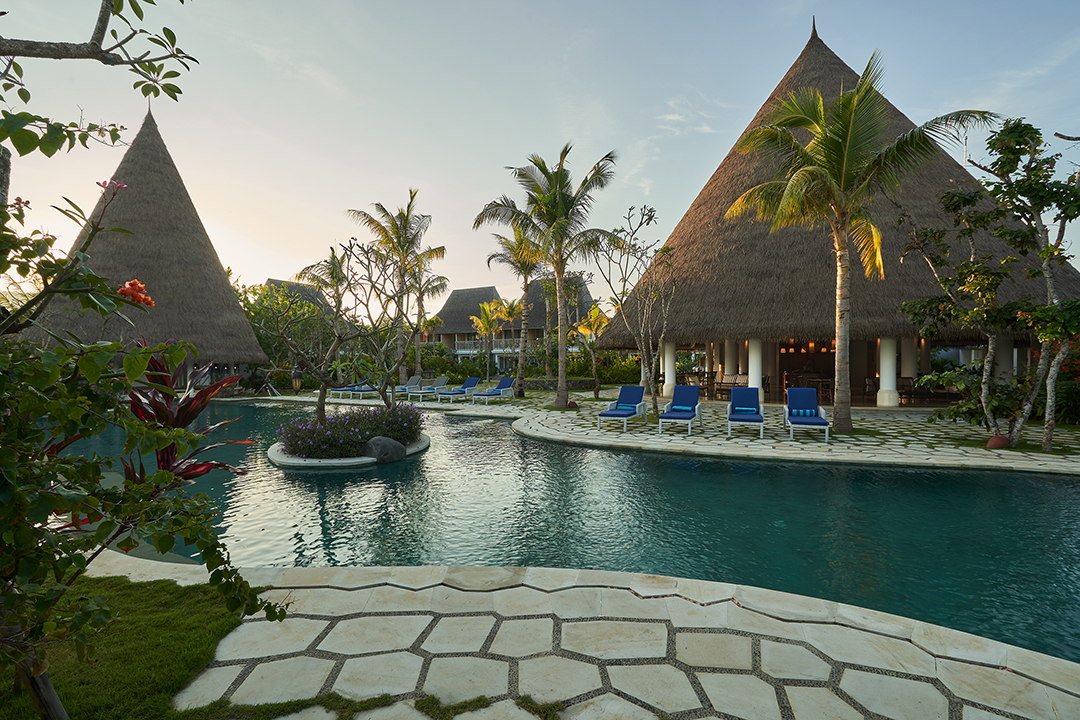Story by Rosiany T. Chandra | Photos by Sudamala Resort, Hidajat Endramukti
Flores’s exotic beauty – both above and below the water – was already well known before Indonesia’s President Joko Widodo introduced the area to leaders of ASEAN countries at the 42nd Summit earlier this year. Labuan Bajo, East Nusa Tenggara is full of island charm. Sudamala Resort, Komodo, is the gateway to the Komodo National Park with its main attraction being the famous Komodo dragon. One of the most sought-after resorts on the island, its location on the western side of Flores Island faces the expansive sea with hills in the background.
The architectural design of Sudamala Resort, Komodo comprising 68 suites and 16 tropical pool villas, is inspired by the wealth of regional art across Nusa Tenggara in particular, the unique local woven fabrics. The result is a design that embodies a strong local spirit alongside the beauty of the beach.
Maintaining the condition of the site, the trees and native vegetation was central to this project. Architect Putu Edy Semara carefully mapped the location of buildings to minimise disturbance of original vegetation and to preserve the native trees. “It symbolises a real appreciation for the energy of life that surrounds the environment,” he said.
Using the generous land size, he aimed to create the atmosphere of a lush labyrinth by creating a network of smaller pathways which connect to bigger open spaces. Putu said that the arid existing environment, gave him the opportunity to create shade using garden framing which then becomes an invitation for guests to explore the tropical oasis. At certain places, water features enhance the outdoor experience. The reason for this is that in hot environments, nothing is more relaxing than being pampered by shade provided by the landscape. The comfort of being in a cosy room, is what the building offers, so the landscape sets the mood.
“This is why we work with fresh vibrant colours inside the building, to continue the connection to fresh green scenery from the luscious landscape,” Putu explained.
Structuring the site plan in this way creates an organic spatial pattern that generates interesting relationships between the buildings and the surrounding space, reminiscent of the unique spatial pattern of villages around Labuan Bajo. This is then reinforced with the use of architectural forms, inspired by the roof forms of traditional houses throughout East Nusa Tenggara. It culminates at a large conical roof shape of the resort’s main all- day dining venue – Wae Rebo Restaurant – inspired by the traditional ‘Mbaru Niang’ house from Wae Rebo village. This emphasis on traditional architecture provides a unique spatial experience.
The resort’s stylish rooms and villas range in size from 40 to 112 sqm, and all have private balconies or terraces. The room categories are: Kelimutu Deluxe Suite, Inerie Garden Suite, Larantuka Panoramic View Suite, Rangko Beachfront Suite, and Manggarai One Bedroom Private Pool Villa. Each room type embodies a different theme and colour tone, for instance, ocean blue is the villa colour scheme set by interior designer Hidajat Endramukti. For the flooring, traditional terrasso floor from Java is used, whilst all the fabrics and accessories are locally sourced. As Hidajat said, this focus on local décor adheres to the resort’s lifestyle focus.
The 32 Kelimutu Deluxe Suites have private terraces overlooking the garden. The 15 Inerie Garden Suites are divided into nine low-level suites and the six upper-level Suites face green landscapes. Closer to the beach are the larger Larantuka Panoramic View Suites and five Rangko Beachfront Suites have views of the sparkling Labuan Bajo waters. The traditional roof design, inspired by ‘Musalaki’ houses have gazebos with private access to the beachfront, perfect for those craving a sunset view.
Set apart from the rest of the property are the 16 Manggarai One Bedroom Private Pool Villas. The bedroom overlooking the pool is decorated with local fabrics, and the use of natural stone and light-coloured wood on panels and furniture throughout create a relaxed and calm ambiance. There is a sense of privacy from the private pergola at the pool to the open-air bathtub and rain shower.
Wae Rebo Restaurant as the centrepiece of the resort, serving local and international cuisines throughout the day. Next door Balenagi Bar with the same conical-shaped roof is a perfect corner for golden hour mingles at sunset with a pre- dinner cocktail or wine. Manta Café, located at the front entrance before the lobby, ensures those guests doing scuba courses by Aqura Dive by day can have lunch afterwards. Located across from Sudajiva Spa and facing the garden suites, the Seraya Gym is open daily for those who don’t want to miss a workout.
There are many ways for guests to unwind at Sudamala Resort, Komodo, including the outdoor pool surrounded by sun-loungers; the serene spa with its private swimming pool for spa guests. The treatment rooms continue the thematic using local fabrics and old Indonesian prints to restore balance and harmony between body and mind instilling a tranquil mood.
The celebration of local textiles and traditional architecture throughout the resort design and a high appreciation to the natural surroundings has made this resort not only impressive physically but on a deeper level it unites art, culture and traditions.
